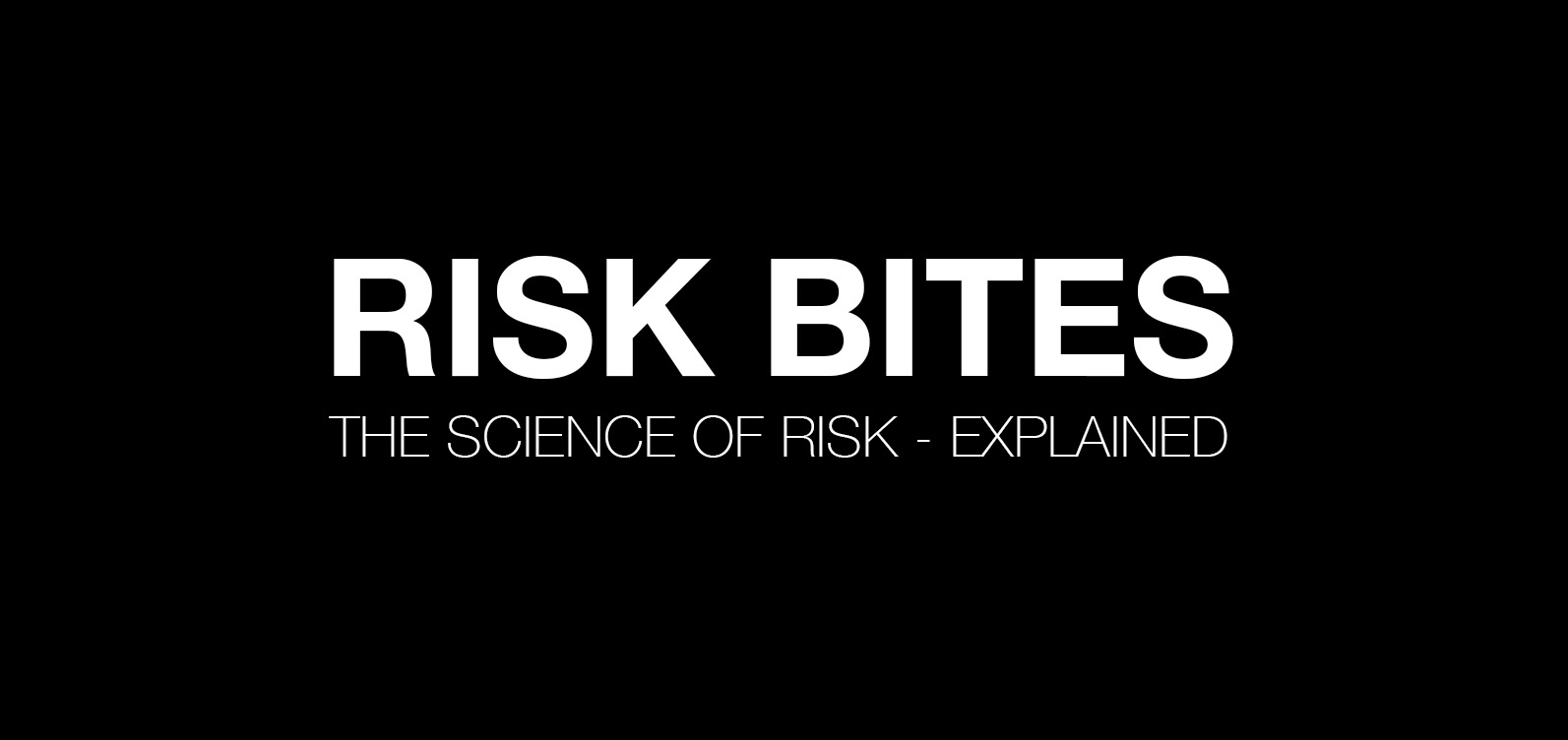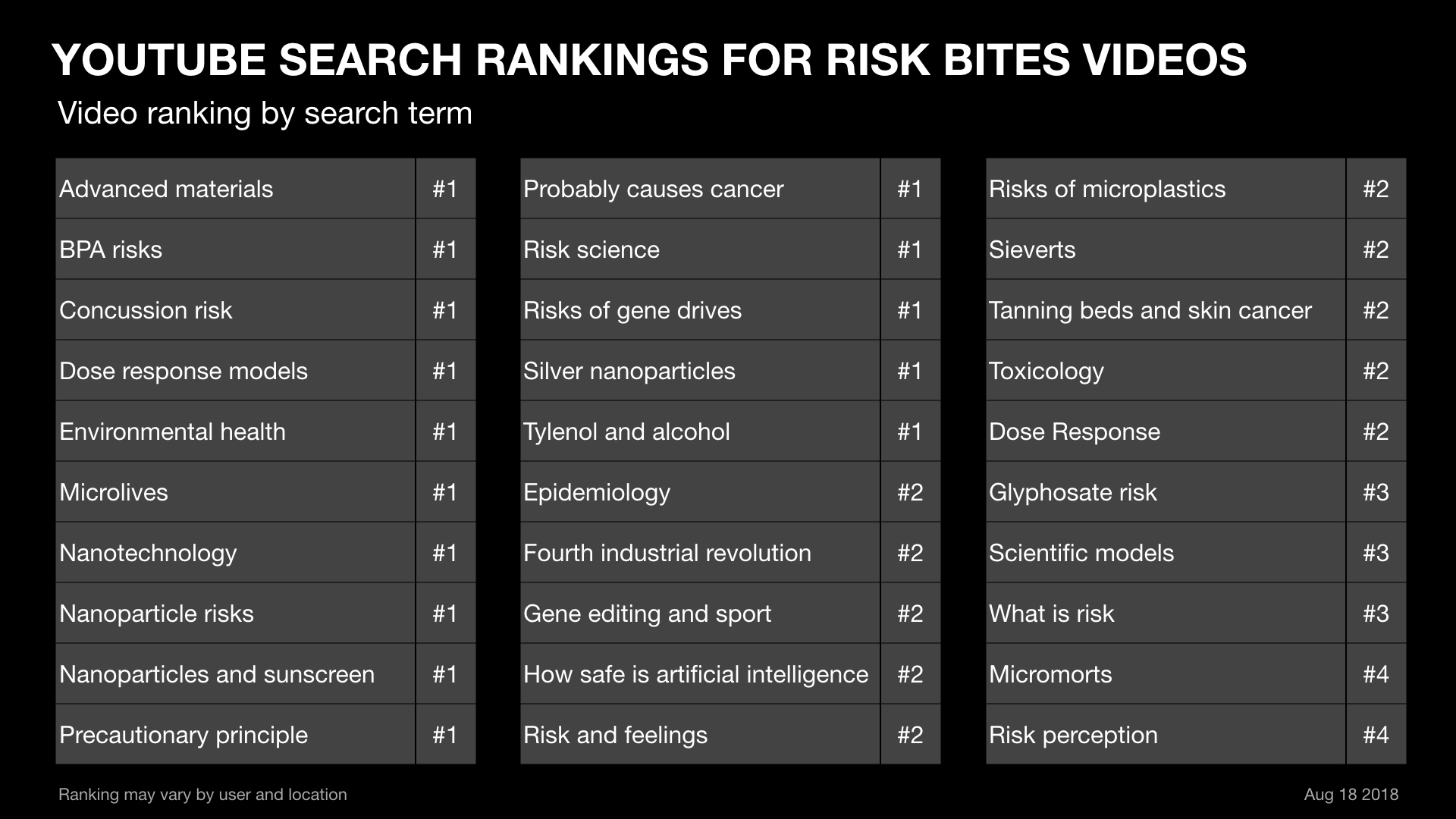It’s been a while coming, but the YouTube channel Risk Bites has just hit 10,000 subscribers. It may not sound a lot when compared to some YouTube mega-channels, but for a low-budget channel that occupies the space between academic expertise and people who just want to know stuff, it’s a pretty major milestone!
I started Risk Bites back in 2012 as an experiment in risk communication. I wanted to see if it was possible for YouTube to be used as an effective education platform by academic experts with no money, little time, and only a scratching of talent. My inspiration was the early work of people like Henry Reich and others, who showed that there’s a hunger for authentic YouTube content that may be rough round the edges in some ways (although this ca be deceptive), but is nevertheless engaging and informative. And I was, I must confess, intrigued of the millions of views that popular science videos were getting, in contrast to the measly tens of views that most academic videos get.
I was also fascinated by the way in which YouTube was increasingly becoming the go-to place for people to learn about stuff — what I’ve previously written abut as “casual learning” — and the quite incredible lack of science content that draws on professional expertise, and is attractive and useful to people who aren’t experts.
In short, I wanted to see if it’s possible to connect academic experts with YouTube users more effectively and authentically, without the need for loads of money, time, and talent.
As you might guess from the fact that it’s taken six years to reach 10,000 subscribers, there have been plenty of reality checks on the way. It turns out that gaining a cult following on YouTube takes more time, money and talent than most senior professors have at their fingertips! But I have found out some useful things on the way, and one of these is understanding the market for science content on YouTube, and ways of gauging success.
Success with niche YouTube audiences
It turns out that, beyond YouTube superstar-channels like SciShow and ASAP Science where people come for the people and stay for the content, it’s surprisingly hard to get consistently large views on science videos. Where views are driven by YouTube searches, they are limited by how many people are actively looking for information on a topic, and where a video appears on the search return. In other words, if there are only a handful of people in the world interested in your topic, search rank, rather than absolute views, is an important metric of success. It not only indicates how discoverable your video is, but how it’s doing against the competition.
Here, I’ve been pleasantly surprised at how well Risk Bites videos fare. In a recent analysis, Risk Bites videos were ranked number 1 in US-based YouTube searches for 15 keywords (see below). These include keywords like “nanotechnology”, “epidemiology” and “environmental health”.
In other words, if someone searches YouTube for “nanotechnology”, the video at the top of the list is a Risk Bites video.
This suggests that, despite the channel still being a niche one, it is hitting key audiences, and providing an important educational and learning resource. What is perhaps shocking though is that this way of assessing success also shows just howe niche some of these audiences are.
The highest-performing video on the channel is “What is Nanotechnology”. It’s the number one ranked YouTube video on nanotechnology in the US, yet it only gets around 500 views per day. In other words, there’s not a huge audience for nanotech videos.
Things get tougher for more esoteric search terms like “microlives”. The video “What are micromorts & microlives, & how are they linked to risk?” is the number one ranked video on YouTube searches for this term. Yet this video gets 6 – 8 views per week, despite its search ranking. Clearly, there aren’t that many people in the world desperately searching for information on microlives!
Search Engine Optimization and knowledge markets
What we’re finding from experiences with Risk Bites is that there are two important factors to YouTube success if you’re an academic wanting to connect what’s in your head with others — beyond the basic ability to make videos that people will want to watch if they can actually find them. These are:
Search Engine Optimization. Even if you make a great video, people simply won’t find it and watch it if it doesn’t appear at the top of YouTube searches (unless you have a cult following of course). There are a few good services for helping with this, including TubeBuddy and VidIQ (I use VidIQ, and find it indispensable). These help craft titles, descriptions and key words that ensure your content has a fighting chance to be discovered amongst all the other content clamoring for people’s attention. They also provide feedback on what’s working and what’s not, as well as how to iteratively improve your chances of being found. And they work.
Realistic Expectations. For most academic experts, there are only going to be so many people in the world who are actively seeking out stuff you know about. And so rather than cross your fingers and hope to go viral with your video, it’s far better to set your sights on reaching these communities — whether they’re just a few hundred people, or a few thousand. This is where search ranking is useful, because it indicates that the people who care about what’s in your videos are more likely to find them.
Of course, if part of your intent is to inform people who may not know they want to be informed, you also have to work out how to grow your potential audience, and how to engage them with your content. This is a next step up from optimizing content for niche audiences, and it’s really, really tough. But with perseverance, attention to detail, and some luck, it’s possible.
Authenticity wins over polish
Over the past six years, something else we’ve discovered is that authenticity is important on YouTube. If you have solid content, and you deliver it in an engaging and authentic way, you’re more likely to get a following than if you are highly polished, yet give the impression you’re on a public relations spree. This isn’t always the case, but as a rule of thumb, it seems to work. And this is great news for academics who are time and cash-strapped, and maybe not the most polished talent around. Because if your audience are excited by who you are and what you’re saying, they can be very forgiving of production quality. There’s even a charm to videos that aren’t that professional. In contrast, videos that are too “corporate” often don’t have the same appeal.
That said, we have found that underpinning Risk Bites videos with high quality audio and narratives helps a lot – despite their “authenticity”, there’s still a lot of work that goes into planning and producing them!
Who is the “we”?
Before I wrap this up, I should say that there’s long been a “we” to Risk Bites, that have underpinned the channel’s success. Over the years, I’ve had some fantastic people working with me on the channel. These have included David Faulkner (who made a huge contribution in the early years), Alyssa Berry, Brian Zikmund-Fisher, Ashley Bieniek-Tobasco, Deise Galan, Clara Petelin, and Mariya Voytyuk (who is the only person besides me to have her own video on the channel!)
Thank you — and for everyone else: Keep on watching!
Just in case you’re interested in more figures, there are over 100 videos on Risk Bites, and since its launch, the channel has has over 1.5 million views. The channel receives around 40,000 views per month, and videos on the channel are watched for the equivalent of 60 days per month. The top-viewed video is “What is nanotechnology?”, clocking in at over 228,000 views. The channel has also had some clunkers. The video PLUTO: A novel way to think about risk, has had less than a thousand views since it’s posting in July 2015 – ouch!


